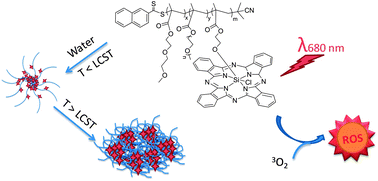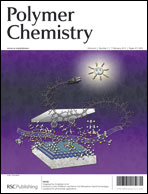A novel multi-targeting nanocarrier (SiPc-polymer) for photodynamic therapy (PDT) has been successfully polymerized via the incorporation of silicon(IV) phthalocyanine dichloride (SiPcCl2) to the thermoresponsive PEG-methacrylates based polymers. The resulting SiPc-polymer was characterized by 1H NMR spectroscopy, GPC, UV-Vis and elemental analysis. The lower critical solution temperature (LCST) of the SiPc-polymer can be easily controlled via changing the ratio of the applied monomers, di(ethylene glycol) methyl ether methacrylate (DEGMEMA), oligo(ethylene glycol) methyl ether methacrylate (OEGMEMA, Mw = 475 g mol−1) and 2-hydroxyethyl methacrylate (HEMA). The synthesized polymers assemble into nanoparticles (70 nm) in aqueous solution, which normally exhibits permeation and retention (EPR) effects, the thermo-responsive features provide the possibility to selectively accumulate at a maligned tissue site upon mild heating and high singlet oxygen quantum yields (ΦΔ = 0.55) are obtained which guarantee the controlled liberation of reactive oxygen species upon light irradiation. This provides a simple way to synthesize a multi-targeting drug carrier system for PDT.

You have access to this article
 Please wait while we load your content...
Something went wrong. Try again?
Please wait while we load your content...
Something went wrong. Try again?


 Please wait while we load your content...
Please wait while we load your content...